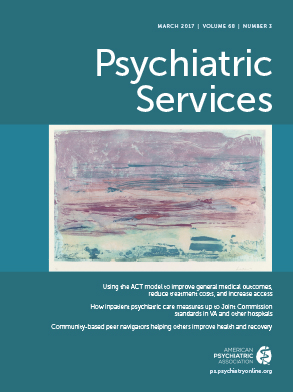TO THE EDITOR: The November Taking Issue column by Marvin S. Swartz (
1) tackles the complex problem of emergency department (ED) boarding and its relationship to inpatient psychiatric bed capacity. As an organization specializing in facility-based crisis services, we are glad to see this issue receive attention and have the following comments:
Although the Smith et al. study (
2) demonstrated that the poorest and sickest languish in EDs the longest, we disagree that there are “vanishingly few realistic alternatives.” Alternatives exist and increasingly are being adopted with positive results. Dedicated crisis centers with the capability to provide on-demand psychiatric assessment, intervention, and discharge planning are associated with reduced ED boarding and inpatient utilization, whether serving a specific ED (
3) or a regional catchment area (
4). Here in Arizona, a state with a long history of managed Medicaid and organized regional planning, such facilities can be found in every metropolitan area. We operate two of the largest, and in our experience the 23-hour observation model allows 60%−70% of patients who would otherwise board in an ED (or jail) to instead transition to less restrictive and less costly community-based care.
However, Swartz appropriately admonishes our field, pointing out that the poorest and sickest have the worst access to care. Mental health providers have a well-deserved reputation for creating overly restrictive exclusionary criteria and other barriers to accessing care. When crisis centers turn away patients according to their behavioral acuity, those most in need of specialized behavioral health care end up restrained on ED gurneys or in jail instead of receiving needed treatment. While communities ideally have a comprehensive crisis continuum that includes such less intensive services, it is critical to have access to facilities capable of safely adhering to a no-refusal policy for even the most acutely ill, especially for patients received via law enforcement (
5).
ED boarding as a proxy for determining the number of inpatient beds needed is an intriguing idea but assumes a direct correlation when the reality is more complicated. In our experience, hospitals often become the default level of care when the community fails to provide a robust programmatic approach to what people need. Over the years we have seen average boarding times fluctuate by as much as 20% while the number of inpatient beds remains constant. Boarding times lengthen when community-based services are unavailable, difficult to access, or slow to respond to requests for assistance in diversion to less restrictive levels of care. Conversely, the addition of new beds has not always resulted in decreased boarding times.
Crisis utilization trends can be a “canary in the coal mine” indicator and inform analyses of the drivers of boarding time other than bed number. To that end, we collaborate with the regional behavioral health authority (the primary public payer) by providing daily data feeds that facilitate more real-time and actionable analysis than those based on claims data.
Thus, crisis programs can help mitigate the ED boarding problem by providing access to emergency psychiatric care and facilitating efforts to improve overall network performance. However, more comprehensive solutions are needed to fully address this complex issue.

